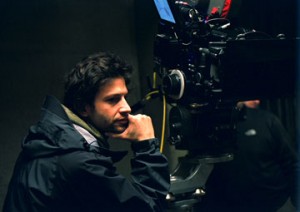Story-telling, Truth, & Cold Blood: Archived Interview w/Moneyball Director Bennet Miller

In February 2006 – weeks following the Oscar-winning Capote’s release and just weeks before the Oscars were announced – I had the good fortune to interview the film’s director Bennet Miller about the boundaries between truth and fiction in both documentaries and features and even about the boyhood roots for telling stories via camera. Miller’s next project came several years later – the just-released and big-buzz feature Moneyball starring Brad Pitt.
If you want to jump down to listen to the never-released interview, scroll below. But if as a creative, a writer, a brand marketer, or anyone interested in the problems of story-telling and truth, you might want to read what’s in between for context.
THE BACK STORY-BEHIND-THE-STORY
One morning in 1959 Truman Capote read a back-page news item about the horrific murder of a reputable Kansan farmer named Herbert Clutter and the rest of his family. His New Yorker editor flew him to Kansas pronto. He knew he had a feature story. But something, many things, happened.
Once Capote started asking Kansans and the killers questions, he also knew he had a book-length story – and he knew he wanted to change forever the way journalists and nonfiction writers tell “real-life” stories by using fiction writers’ story-telling devices in the service of nonfiction. So began Capote’s journey in writing arguably one of the 20th century’s most influential nonfiction books, In Cold Blood (Here are photos of Capote while researching the book). But there’s another story.
For six years while trying to finish the book, Capote fought his demons of doubt, insecurity, and addiction, and he also grew peculiarly close to one of the killers. Is the author using the killer for a great story, or is the killer using the author? What are the lines between art and morality? Where does truth overlap with fiction?
PROBLEMS FOR A KEEN CINEMATIC STORY-TELLER
How do you tell that story in film? And in a way that resists conventional “biopic” tropes or that resists making a caricature of the toad-like writer with the affected voice?
Those were among the challenges of Bennett Miller, the young, low-key director of the 2005 Oscar-winning feature drama Capote. In 2006, I interviewed him about those challenges of story-telling and more.
Toward the interview’s end, I asked Miller about his next project. He judiciously said he would wait before jumping back into directing a major film. And he did. Six years later, his next film Moneyball just came out – the much talked-about Brad Pitt feature that took ten years to make. It also tells the “true” story of another larger-than-life figure, the Oakland A’s manager Billy Beane who did to baseball what Capote did to nonfiction – changed it forever.
Miller apparently likes a challenge. He was the third and only successful director assigned to the film. Pitt acknowledged in a recent interview, “It took Bennet Miller to crack this unconventional story.”
THE INTERVIEW
Note: Today is the first time this interview has been made public. I conducted it as part of a web radio program that never launched. Miller was exhausted the morning of the interview – he had just returned from three international cities in two days. But he gave a great interview (despite his doubts following it). In what is more like a conversation, we explore issues that matter to anyone interested in challenges of story-telling: choosing unique angles for a good story versus standard biography fact-dumps, challenges for crafting truthful stories, the ethics of “using” a subject for a good story, & much more. I hope you enjoy it.
0:05 – choosing the unique story angle
2:10 – complicating audience sympathy beyond good and evil
6:10 – the problems of being truthful as creatives
9:45 – truth in portrait documentaries versus feature films
12:40 – a creative’s ethical considerations of “using” a subject for a good story
19:06 – hard work + right intention + talent: how Phillip Seymour-Hoffman portrays Capote beyond caricature
23:05 – slide show memories & dreams: boyhood roots of a smart filmmaker
26:44 – the importance of retreating
DROP IN THE HUT
What are the problems between facts and truth you face in story-telling? Enjoy the interview-conversation, and let us know what you think about the interview and the questions it raises. And then go see Moneyball.
See you in the woods,
Jeffrey
Great interview – insightful, intelligent discussion of Miller’s work – can’t wait to see Moneyball!
Thanks for your good words. Glad you enjoyed it – and let me know what you think of Moneyball.
It’s a fine and foggy line when depicting real people in film or a book. I think trusting the gut is the only real guideline. I found it fascinating that Miller wasn’t sure he’d depict the murderer so sympathetically and Capote so negatively if he had to do it again. It was a terrific film that suggested that Capote’s disdainful obsession with the Kansas murders was possibly as crazy as the murderer’s bungled robbery. Thanks for sharing!
Robin: I appreciate your perspective since you have “real-world” experience in making these choices. Knowing how to trust the gut – or even know when the gut is speaking or if it’s just indigestion 🙂 – is really tricky for a lot of creatives. I also appreciated Miller’s perspective about his depictions. Thanks for dropping in the hut. Always good to hear what you have to say.